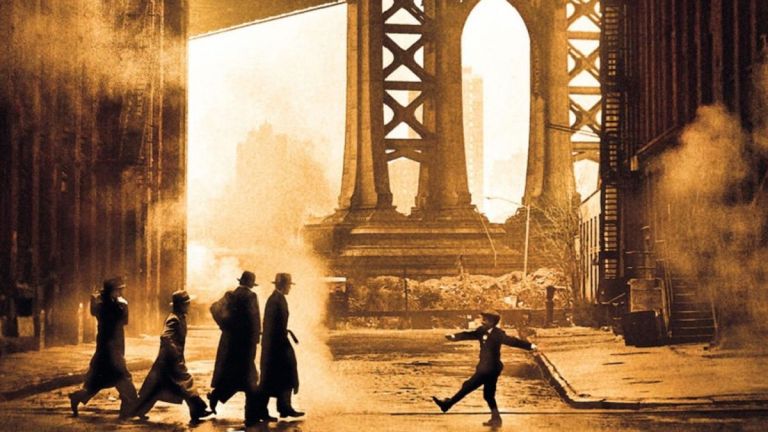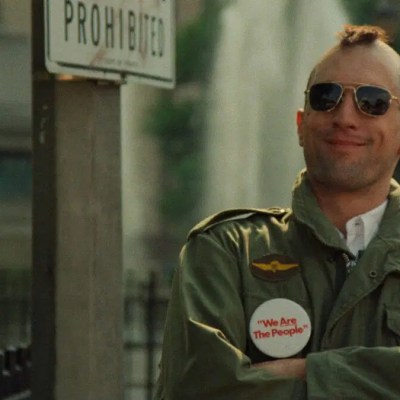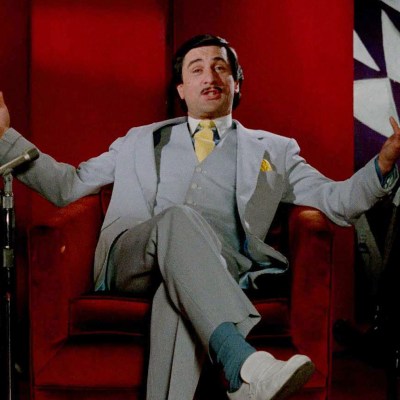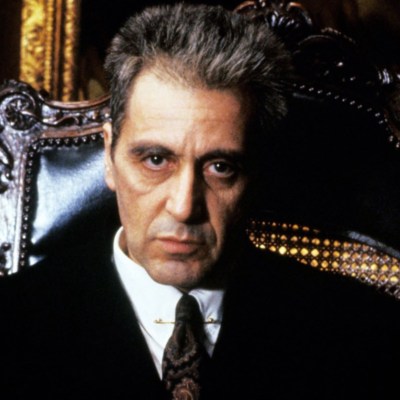Once Upon a Time in America Is Every Bit as Great a Gangster Movie as The Godfather
Robert De Niro and James Woods created gangster icons for Sergio Leone’s mob masterpiece, Once Upon a Time in America.

This article contains Once Upon a Time in America spoilers.
The Godfather is a great movie, possibly the best ever made. Its sequel, The Godfather, Part II, often follows it in the pantheon of classic cinema, some critics even believe it is the better film. Robert Evans, head of production at Paramount in the early 1970s, wanted The Godfather to be directed by an Italian American. Francis Ford Coppola was very much a last resort. The studio’s first choice was Sergio Leone, but he was getting ready to make his own gangster epic, Once Upon a Time in America. Though less known, it is equally magnificent.
Robert De Niro, as David “Noodles” Aaronson, and James Woods, as Maximillian “Max” Bercovicz, make up a dream gangster film pairing in Once Upon a Time in America, on par with late 1930s audiences seeing Humphrey Bogart and James Cagney team for The Roaring Twenties or Angels with Dirty Faces. Noodles and Max are partners and competitors, one is ambitious, the other gets a yen for the beach. One went to jail, the other wants to rob the Federal Reserve Bank.
Throw Joe Pesci into the mix, in a small part as crime boss Frankie Monaldi, and Burt Young as his brother Joe Monaldi, and life gets “funnier than shit,” and funnier than their more famous crime films, Goodfellas and Chinatown, respectively. Future mob entertainment mainstays are all over Once Upon a Time in America too, and they are in distinguished company. This is future Oscar winner Jennifer Connelly’s first movie. She plays young Deborah, the young girl who becomes the woman between Noodles and Max, and she even has something of a catch-phrase, “Go on Noodles your mother is calling.” Elizabeth McGovern delivers the line as adult Deborah.
When Once Upon a Time in America first ran in theaters, there were reports that people in the audience laughed when Deborah is reintroduced after a 35-year gap in the action. She hadn’t aged at all. But Deborah is representational to Leone, beyond the character.
“Age can wither me, Noodles,” she says. But neither the character nor the director will allow the audience to see it beyond the cold cream. Deborah is the character Leone is answering to. She also embodies the fluid chronology of the storytelling. She is its only constant.
The rest of the film can feel like a free fall though. Whereas The Godfather moved in a linear fashion, Once Upon a Time in America has time for flashbacks, and flashbacks within flashbacks, and detours that careen between the violent and the quiet. It’s a visceral experience about landing where we, and this genre, began.
Growing up Gangster
Both The Godfather and Once Upon a Time in America span decades; it’s the history of immigrant crime in 20th century America. But they differ on chronological placement. Once Upon a Time is set in three time-frames. The earliest is 1918 in the Jewish ghettos of New York City’s Lower East Side.
Young Noodles (Scott Tiler), Patrick “Patsy” Goldberg (Brian Bloom), Philip “Cockeye” Stein (Adrian Curran) and Dominic (Noah Moazezi), are a bush league street gang doing petty crimes for a minor neighborhood mug, Bugsy (James Russo). New on the block, Max (Rusty Jacobs) interrupts the gang as they’re about to roll a drunk, and Max makes off with the guy’s watch for himself. He soon joins the gang, and they progress to bigger crimes.
The bulk of the film takes place, however, from when De Niro’s Noodles gets out of prison in 1930, following Bugsy’s murder, and lasts until the end of Prohibition in 1933. Max, now played by Woods, has become a successful bootlegger with a mortuary business on the side. With William Forsythe playing the grown-up Cockeye and James Hayden as Patsy, the mobsters go from bootlegging through contract killing, and ultimately to backing the biggest trucking union in the country as enforcers. They enjoy most of their downtime in their childhood friend Fat Moe’s (Larry Rapp) speakeasy. Noodles is in love with Fat Moe’s sister, Deborah, who is on her way to becoming a Hollywood star. The gang’s rise ends with the liquor delivery massacre.
The final part of the film comes in 1968. After 35 years in hiding, Noodles is uncovered and paid to do a private contract for the U.S. Secretary of Commerce Christopher Bailey… Max by a different name who 35 years on has been able to feign respectability and make Deborah his mistress. An entire life has become a façade.
Recreating a Seedier Side of New York’s Immigrant Past
While The Godfather is an adaptation of Mario Puzo’s fictional bestseller, Once Upon a Time in America is based on the autobiographical crime novel, The Hoods. It was written by Herschel “Noodles” Goldberg, under the pen name of Harry Grey while he was serving time in Sing-Sing Prison.
Coppola’s vision in The Godfather is aesthetically comparable to Leone’s projection. From the opium pipes at the Chinese puppet theater to the take-out Lo Mein during execution planning, the multicultural world of old New York crowds the frames and the players in both films. Most of Once Upon a Time in America was shot at Rome’s Cinecittà Studios. The 1918 Jewish neighborhood in Manhattan was a street in Williamsburg, Brooklyn, which was made to look exactly as it had 60 years earlier.
Leone skillfully, yet playfully, captures the poverty of immigrant life in New York. The first crime we see the four-member gang commit could have been done by the Dead End kids. They torch a newspaper stand because the owner doesn’t kick up protection money to the local mug. And like the Dead End kids, they needle their mark, and joke with each other. At the end of the crime, Cockey is playing the pan pipe, and the very young Dominic is dancing. They are proud of their work and enjoy it. It’s fun to break things for money. And even better when they get a choice between taking payment in cash or rolling it over into the sure bet of rolling a drunk.
Violence without the Cannoli
Gangster films, like Howard Hawks’ Scarface and William A. Wellman’s The Public Enemy, were always at the forefront of the backlash to the Motion Picture Production Code. Which might be why gangster pictures were one of the first genres to benefit from the censors’ fall. A direct line can be drawn from the machine gun death which ends Bonnie and Clyde (1967) to the toll-booth execution of Sonny Corleone (James Caan) in The Godfather. Another from when Moe Greene (Alex Rocco) gets one through the glasses and Joe Monaldi gets it in the eye in Once Upon a Time in America.
The Godfather has some brutal scenes. We get a litany of dead Barzinis and Tattaglias, horse heads and spilled oranges. Once Upon a Time in America ups the ante though. The shootings and stabbings are neat jobs compared with the beatings, which allow far more artistic renderings of gore, and pass extreme scrutiny. The one time the effects team balks at a payoff is when it’s not as gruesome as the setup.
“Inflammatory words from a union boss,” corporate thug Chicken Joe asks as he is about to light Jimmy “Clean Hands” Conway O’Donnell on fire. The mobster has such a nice smile, and the union delegate, played by Treat Williams, looks so pathetic while dripping gasoline that it feels like it might even be a mercy killing. It is a wonderful set piece, perfectly executed and timed. When Max and Noodles, and the gang defuse the situation, rather than ignite it, it is a lesson in the dangerous balance of suspense.
Like many specific scenes in Once Upon a Time in America, Conway’s incendiary introduction would’ve worked in any era. This is the turning point for the gang. The end of Prohibition is coming and all those trucks they’re using to haul liquor can be repurposed for a more lucrative future.
“You Dancing?”
Music is paramount in both Leone’s and Coppola’s films. The Godfather is much like an opera, the third installment even closes the curtain at one. Once Upon a Time in America is a frontier film. The score was composed by Ennio Morricone, who wrote the music behind Leone’s A Fistful of Dollars, For A Few Dollars More, and The Good, the Bad and the Ugly.
The film opens and closes with Kate Smith’s version of “God Bless America.” Though the scene occurs during the 1968 timeframe, the song comes out of the radio of a car seemingly from another point in time.
Morricone’s accompaniment to Once Upon a Time in America is as representational as Nino Rota’s soundtrack in The Godfather. Characters, settings, situations, and relationships all have themes, which become as recognizable as the Prohibition-era songs which flavor the period piece’s ambience. Fat Moe conducts the speakeasy orchestra through José María Lacalle García’s “Amapola” while grinning dreamily to Deborah who is chatting with Noodles. He’s a romantic.
The music becomes part of the action in Once Upon a Time in America. Individual couples cut their own rugs, doing the Charleston between tables as waiters and cigarette girls glide by. Cockeye, who has been playing the pan pipe since the beginning of the film, wants to sit in with the band.
Forsythe almost steals Once Upon a Time in America. He cries what look like real tears at the mock funeral for Prohibition and drinks formula from a baby bottle during the maternity ward scene. The blackmail scheme, which involves swapping infants, plays like an outtake from a Three Stooges movie, something Coppola would never dare for The Godfather. The ruse is choreographed to the tune of Gioachino Rossini’s “The Thieving Magpie,” which elicits the youthful thuggery celebrated in Stanley Kubrick’s A Clockwork Orange.
Devils with Clean Faces
One ironic difference between the two films is whimsy. The Godfather, which glorifies crime as corporate misadventure, is a serious movie with no time for funny business. Once Upon a Time in America, which is an indictment of criminal life, has moments of innocence as syrupy as in any family film (of the non-crime variety) and can be completely kosher. It’s sweeter than the cannoli Clemenza (Richard Castellano) took from the car, or the cake Nazorine (Vito Scotti) made for the wedding of Don Vito’s daughter.
The scene where young Patsy brings a Charlotte Russe to Peggy in exchange for sex is a masterwork of emotive storytelling. He chooses a treat over sex. On one level, yes, this is a socioeconomic reality. That pastry was expensive and something he could never afford to get for himself. But as Patsy sneaks each tiny bit of the cream from the packaging, he is also just a child, a kid who wants some cake. He learns he can’t have it and eat it. It is so plainly laid out, and so beautifully rendered.
The Corleone family never gets those moments, not even in the flashbacks to Sicily or as children on the stoop listening to street singers play guitars. We know little of Michael Corleone (Al Pacino) or Sonny as youngsters, much less teenagers, and are robbed of their happier moments of bonding. We know they are close, they are family. But Michael has his own brother killed while Noodles balks at the very idea. Twice, as it turns out.
“Today they ask us to get rid of Joe. Tomorrow they ask me to get rid of you. Is that okay with you? Cos it’s not okay with me,” Noodles tells Max after the gang delivers on a particularly costly contract, double-crossing their partners in a major diamond heist. They are not blood family, but from the moment Max calls Noodles his “uncle” to fool a beat cop, they are all related.
Noodles then does what young men in coming-of-age movies have done since Cooley High: Something really stupid. An indulgence the Corleones could never enjoy. He speeds the car into the bay. The guys can’t believe it. It adds to his legend. The scene could have been in Diner, Ferris Bueller’s Day Off, or even Thelma & Louise. It is hard to dislike the gangsters in these moments. We know them too well, even as they do such horrible things.
How Women are Really Treated by an Underworld
The Godfather is told from the vantage point of one of the heads of the five established crime families; organized crime is as insular as the Corleone mall on Long Beach. That motion picture reinvigorated the “gangster film,” long considered a ghetto genre, but its perspective is insulated. By contrast, no matter how far they climb, Leone’s characters never really get off the block. They are street savages, even in tuxedos. Once Upon a Time in America whacked the gangster film, and tossed its living corpse into the compactor of a passing garbage truck.
The Godfather doesn’t judge its gangsters. The Corleones are family men who keep to a code of ethics and omerta. They dip their beaks in “harmless” vices like gambling, liquor, and prostitution. While there are scenes of extreme domestic violence, and a general dismissal of women, the film stops short of challenging the image of honorable men who do dishonorable things. Leone offers no such restraint. His history lesson is unabridged.
Long before Martin Scorsese’s The Irishman stripped gangster lore to a tale of toxic masculinity, Once Upon a Time in America robbed it of all glamor. There is a very nonchalant attitude toward violence and other demeaning acts against women in Leone’s film, from the very opening scene where a thug fondles a woman’s breast with his gun in order to humiliate her civilian date.
This is deliberate. The director, best known for Spaghetti Westerns, wants to obliterate any goodwill the gangsters have accumulated through their magnetic antiheroism. One scene between Max and his girlfriend Carol (Tuesday Weld) is so hard to sit through, even the other members of the gang squirm in their chairs.
Noodles sexually assaults two women over the course of the film. While there is some motivational ambiguity in the scene during the jewel heist attack, the rape of Deborah is devastatingly direct. It kills any vestige of romance the gangster archetype has in film. The camera does not look away, and the scene lingers with terrifying ferocity and traumatic intimacy. There is a visible victim, and Noodles’ wealth and pretensions of honor are worthless.
The Ultimate Gangster Epic
Once Upon a Time in America brings one other element to the genre which The Godfather avoids, a lingering mystery. Coppola delivers short riddles, like the fate of Luca Brasi, which are revealed as the story warrants. But the 35-year gap between the slaughter of Noodles’ crew and the introduction of Secretary Bailey is almost unfathomable. How did Max go from long-dead to a man with legitimate power?
What happens to Noodles in those years is fairly easy to guess, without any specifics. He got by. The gang’s shared secret bankroll was empty when he tried to retrieve it as the last surviving member. He put his gun away and eked out a quiet life. But even as the details spill out on the true fate of Max, it is unexpectedly surprising, as much for the audience as Noodles.
“I took away your whole life from you,” Max/Bailey says. “I’ve been living in your place. I took everything. I took your money. I took your girl. All I left for you was 35 years of grief over having killed me. Now why don’t you shoot?” This final betrayal, and Noodles’ inert revenge, take Once Upon a Time In America into almost unexplored cinematic depths.
Max has gone as low as he could go. The joke is on Noodles, everyone’s in on it, including “Clean Hands,” who is tied in to “the Bailey scandal.” The cops are in on it, and so is the mob. Max admits even the liquor dropoff was a syndicate set-up. He’d planned this all along. Just like Michael Corleone had a long term strategy to make his family legitimate.
This is an ambitious story. Beyond genre, this bends American celluloid into European cinema. By sheer virtue of being outside of Hollywood, Leone transcends traditional boundaries. He has a far more limitless pallet to draw from. He can aim a camera at De Niro’s spoon in a coffee cup for three minutes and never lose the audience’s rapt attention. Leone can pull the rug out from everything with a last minute reveal. Coppola bent American filmmaking for The Godfather, but stayed within proscribed parameters. He never gets as sweet as a Charlotte Russe nor as repulsive as the back seat of a limo.
Once Upon a Time in America ripped the genre’s insides out and displayed them with unflinching veracity and theatrical beauty. It is a perfect film, gorgeously shot, masterfully timed, and slightly ajar.



